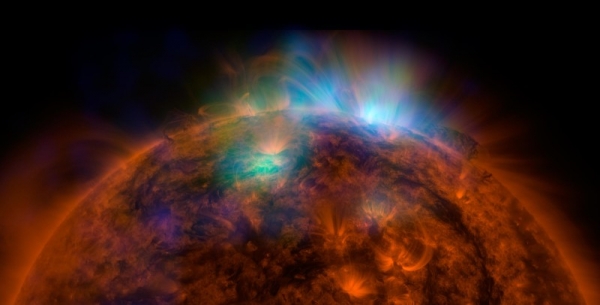NASA's NuStar Takes its First X-Ray Portrait of the Sun
| Marco Foronda | | Dec 24, 2014 04:12 AM EST |
(Photo : NASA/JPL-Caltech/GSFC) X-rays stream off the sun in this image combining data from NASA's Nuclear Spectroscopic Telescope Array (NuSTAR) space telescope, overlaid on a photo taken by NASA's Solar Dynamics Observatory (SDO).
NASA's Nuclear Spectroscopic Telescope Array or NuSTAR has taken its first X-ray photo of the Sun.
According to NASA, the Sun's image is the "most sensitive solar portrait ever taken in high-energy X-rays."
NASA said the first image covers the so-called west limb of the Sun. The Solar Dynamics Observatory (SDO) caught the image and it's ready to make it wallpaper-ready for people's devices.
Like Us on Facebook
"NuSTAR will give us a unique look at the sun, from the deepest to the highest parts of its atmosphere," said David Smith, a solar physicist and member of the NuSTAR team at University of California, Santa Cruz.
Smith convinced Fiona Harrison of the California Institute of Technology in Pasadena that NuStar can be used to see the X-ray flashes predicted by theorists.
Now, NuStar confirms it can really collect data about the Sun and offer insights into questions regarding the exceptionally high temperatures found above sunspots (cool, dark patches on the Sun).
The Sun's first X-ray image shows high-energy X-rays not visible to the naked eye. The X-rays come from gas heated to above three million degrees Celsius. The non-red bits seen in the image are lower-temperature material in the solar atmosphere with a temperature closer to one million degrees Celsius.
NuStar can even take photos of nanoflares, smaller versions of the Sun's giant flares that erupt with charged particles and high-energy radiation. If NuStar could take images of nanoflares in action, these photos may finally solve this decades-old mystery about nanoflares.
TagsNASA, NuStar, Sun's first image, nanoflares, Sunspot, high-energy X-rays, Sun's X-ray
©2015 Chinatopix All rights reserved. Do not reproduce without permission
EDITOR'S PICKS
-

Did the Trump administration just announce plans for a trade war with ‘hostile’ China and Russia?
-

US Senate passes Taiwan travel bill slammed by China
-

As Yan Sihong’s family grieves, here are other Chinese students who went missing abroad. Some have never been found
-

Beijing blasts Western critics who ‘smear China’ with the term sharp power
-

China Envoy Seeks to Defuse Tensions With U.S. as a Trade War Brews
-

Singapore's Deputy PM Provides Bitcoin Vote of Confidence Amid China's Blanket Bans
-

China warns investors over risks in overseas virtual currency trading
-

Chinese government most trustworthy: survey
-

Kashima Antlers On Course For Back-To-Back Titles
MOST POPULAR
LATEST NEWS
Zhou Yongkang: China's Former Security Chief Sentenced to Life in Prison

China's former Chief of the Ministry of Public Security, Zhou Yongkang, has been given a life sentence after he was found guilty of abusing his office, bribery and deliberately ... Full Article
TRENDING STORY

China Pork Prices Expected to Stabilize As The Supplies Recover

Elephone P9000 Smartphone is now on Sale on Amazon India

There's a Big Chance Cliffhangers Won't Still Be Resolved When Grey's Anatomy Season 13 Returns

Supreme Court Ruled on Samsung vs Apple Dispute for Patent Infringement

Microsoft Surface Pro 5 Rumors and Release Date: What is the Latest?










